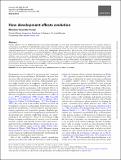Files in this item
How development affects evolution
Item metadata
| dc.contributor.author | González-Forero, Mauricio | |
| dc.date.accessioned | 2023-02-09T18:30:07Z | |
| dc.date.available | 2023-02-09T18:30:07Z | |
| dc.date.issued | 2023-02-01 | |
| dc.identifier | 276371517 | |
| dc.identifier | 8ecbec4a-c1a5-45ec-aaed-864972fe98b0 | |
| dc.identifier | 85147458205 | |
| dc.identifier.citation | González-Forero , M 2023 , ' How development affects evolution ' , Evolution , vol. 77 , no. 2 , qpac003 , pp. 562-579 . https://doi.org/10.1093/evolut/qpac003 | en |
| dc.identifier.issn | 1558-5646 | |
| dc.identifier.other | ORCID: /0000-0003-1015-3089/work/125303235 | |
| dc.identifier.uri | https://hdl.handle.net/10023/26943 | |
| dc.description | Funding: This work was funded by an ERC Consolidator Grant to A. Gardner (grant no. 771387), by the School of Biology of the University of St Andrews, and by a John Templeton Foundation grant to K.N. Laland and T. Uller (grant ID 60501). | en |
| dc.description.abstract | Natural selection acts on developmentally constructed phenotypes, but how does development affect evolution? This question prompts a simultaneous consideration of development and evolution. However, there has been a lack of general mathematical frameworks mechanistically integrating the two, which may have inhibited progress on the question. Here, we use a new mathematical framework that mechanistically integrates development into evolution to analyse how development affects evolution. We show that, while selection pushes genotypic and phenotypic evolution up the fitness landscape, development determines the admissible evolutionary pathway, such that evolutionary outcomes occur at path peaks rather than landscape peaks. Changes in development can generate path peaks, triggering genotypic or phenotypic diversification, even on constant, single-peak landscapes. Phenotypic plasticity, niche construction, extra-genetic inheritance, and developmental bias alter the evolutionary path and hence the outcome. Thus, extra-genetic inheritance can have permanent evolutionary effects by changing the developmental constraints, even if extra-genetically acquired elements are not transmitted to future generations. Selective development, whereby phenotype construction points in the adaptive direction, may induce adaptive or maladaptive evolution depending on the developmental constraints. Moreover, developmental propagation of phenotypic effects over age enables the evolution of negative senescence. Overall, we find that development plays a major evolutionary role. | |
| dc.format.extent | 18 | |
| dc.format.extent | 34869020 | |
| dc.language.iso | eng | |
| dc.relation.ispartof | Evolution | en |
| dc.subject | Evo-devo | en |
| dc.subject | Genetic constraints | en |
| dc.subject | G matrix | en |
| dc.subject | Ageing | en |
| dc.subject | Evolutionary dynamics | en |
| dc.subject | Fitness landscapes | en |
| dc.subject | QH426 Genetics | en |
| dc.subject | NDAS | en |
| dc.subject | MCC | en |
| dc.subject.lcc | QH426 | en |
| dc.title | How development affects evolution | en |
| dc.type | Journal article | en |
| dc.contributor.sponsor | John Templeton Foundation | en |
| dc.contributor.sponsor | European Research Council | en |
| dc.contributor.institution | University of St Andrews. Centre for Biological Diversity | en |
| dc.contributor.institution | University of St Andrews. School of Biology | en |
| dc.identifier.doi | https://doi.org/10.1093/evolut/qpac003 | |
| dc.description.status | Peer reviewed | en |
| dc.identifier.url | https://www.biorxiv.org/content/10.1101/2021.10.20.464947v3 | en |
| dc.identifier.grantnumber | 60501 | en |
| dc.identifier.grantnumber | 771387 | en |
This item appears in the following Collection(s)
Items in the St Andrews Research Repository are protected by copyright, with all rights reserved, unless otherwise indicated.

